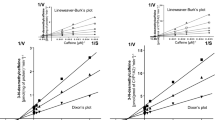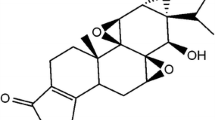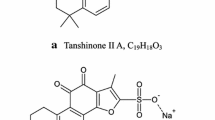Abstract
Objective: The nature of the enzyme(s) catalysing the biotransformation of lornoxicam to one of its major metabolites, 5′-hydroxy-lornoxicam, has been investigated in human liver microsomes. The reaction kinetics were characterised, the affinity of lornoxicam for three major human drug metabolising cytochrome P-450 isozymes (CYP2C9, CYP2D6 and CYP3A4) was determined, and inhibition of the reaction by known substrates (diclofenac, ibuprofen, mefenamic acid, phenytoin, tolbutamide and warfarin) and the prototype inhibitor (sulphaphenazole) of CYP2C9 was investigated.
Results: Lornoxicam 5′-hydroxylation displayed single enzyme Michaelis-Menten kinetics, with a KM of 3.6 μmol·l-1 and a Vmax of 2.6 nmol·h-1·mg-1 microsomal protein. The apparent affinity of lornoxicam was high for CYP2C9, but negligible for CYP3A4 and CYP2D6. Inhibition of lornoxicam 5′-hydroxylation by CYP2C9 substrates and sulphaphenazole was comparable in all livers preparations, values predicted from their KM or Ki for CYP2C9 determined in separate studies assuming competitive inhibition. Sulphaphenazole competitively and completely inhibited lornoxicam 5′-hydroxylation (Ki=0.31 μmol·l-1) as well as lornoxicam clearance (Ki=0.33 μmol·l-1), partial metabolic clearance (fm)=0.95).
Conclusion: 5′-Hydroxylation appears to be the only cytochrome P-450 catalysed metabolic reaction of lornoxicam by human liver microsomes and this major in vivo biotransformation pathway is catalysed virtually exclusively by CYP2C9.
Similar content being viewed by others
References
Nelson DR, Kamataki T, Waxman DJ, Guengerich FP, Estabrook RW, Feyereisen R, Gonzalez FJ, Coon MJ, Gunsalus IC, Gotoh O, Okuda K, Nebert DW (1993) The P450 superfamily: update on new sequences, gene mapping, accession numbers, early trivial names of enzymes, and nomenclature. DNA Cell 12: 1–51.
Hermans JJ, Thijssen HH (1993) Human liver microsomal metabolism of the enantiomers of warfarin and acenocoumarol: P450 isozyme diversity determines the differences in their pharmacokinetics. Br J Pharmacol 110: 482–490.
Veronese ME, Mackenzie PI, Doecke CJ, Mc Manus ME, Miners JO, Birkett DJ (1991) Tolbutamide and phenytoin hydroxylations by cDNA-expressed human liver cytochrome P4502C9. Biochem Biophys Res Commun 175: 1112–1118.
Doecke CJ, Veronese ME, Pond SM, Miners JO, Birkett DJ, Sansom LN, Mc Manus ME (1991) Relationship between phenytoin and tolbutamide hydroxylations in human liver microsomes. Br J Clin Pharmacol 31: 125–130.
Rettie AE, Korzekwa KR, Kunze KL, Lawrence RF, Eddy AC, Aoyama T, Gelboin HV, Gonzalez FJ, Trager WF (1992) Hydroxylation of warfarin by human cDNA-expressed cytochrome P-450:a role for P-450 2C9 in the etiology of (S)-warfarin drug interactions. Chem Res Toxicol 5: 54–59.
Leemann T, Transon C, Dayer P (1993) Cytochrome P450tb (CYP2C): a major monooxygenase catalyzing diclofenac 4′-hydroxylation in human liver. Life Sci 52: 29–34.
Leemann T, Bonnabry P, Dayer P (1994) Stereo- and nonstereoselective oxidation by hepatic P450tb (CYP2C): The major elimination pathway of (±)-ibuprofen in humans. Clin Pharmacol Ther 55: 208.
Bonnabry P, Leemann T, Dayer P (1994) Biotransformation by hepatic P450tb (CYP2C) controls mefenamic acid elimination. Clin Pharmacol Ther 55: 139.
Kondo M, Leemann T, Dayer P (1992) Piroxicam 5′-hydroxylation is catalyzed by human cytochrome P450tb (CYP2C). Experientia 48:A7.
Zhao J, Leemann T, Dayer P (1992) In vitro oxidation of oxicam NSAIDs by a human liver cytochrome P450. Life Sci 51: 575–581.
Hitzenberger G, Radhofer-Welte S, Takacs F, Rosenow D (1990) Pharmacokinetics of lornoxicam in man. Postgrad Med J 66 [Suppl 4]: S22-S27.
Turner P, Johnston A (1990) Clinical pharmacokinetic studies with lornoxicam. Postgrad Med J 66 [Suppl 4]: S28-S29.
Back DJ, Tjia JF, Karbwang J, Colbert J (1988) In vitro inhibition studies of tolbutamide hydroxylase activity of human liver microsomes by azoles, sulphonamides and quinolines. Br J Clin Pharmacol 26: 23–29.
Von Bahr C, Groth CG, Jansson H, Lundgren G, Lind M, Glaumann H (1980) Drug metabolism in human liver in vitro: Establishment of a human liver bank. Clin Pharmacol Ther 27: 711–725.
Dayer P, Kronbach T, Eichelbaum M, Meyer UA (1987) Enzymatic basis of the debrisoquine/sparteine-type genetic polymorphism of drug oxidation. Biochem Pharmacol 36: 4145–4152.
Dayer P, Leemann T, Striberni R (1989) Dextromethorphan O-demethylation in liver microsomes as a prototype reaction to monitor cytochrome P450dbl activity. Clin Pharmacol Ther 45: 34–40.
Lowry OH, Rosebrough NJ, Farr AL, Randall RJ (1951) Protein measurement with the Folin phenol reagent. J Biol Chem 193: 265–275.
Gascon MP, Dayer P (1991) In vitro forecasting of drugs which may interfere with the biotransformation of midazolam. Eur J Clin Pharmacol 41: 573–578.
Holford N. MKMODEL (version 4.42) User Manual (1991) Biosoft, Cambridge, UK.
Dixon M (1953) The determination of enzyme inhibitor constants. Biochem J 55: 170–171.
Cornish-Bowden A (1974) A simple graphical method for determining the inhibition constant of mixed, uncompetitive and non-competitive inhibitors. Biochem J 137: 143–144.
Author information
Authors and Affiliations
Additional information
Supported in part by Hafslund Nycomed Pharma AG (Linz, Austria) and by a grant of the Forschungsförderungsfond der Gewerblichen Wirtschaft Österreichs
Rights and permissions
About this article
Cite this article
Bonnabry, P., Leemann, T. & Dayer, P. Role of human liver microsomal CYP2C9 in the biotransformation of lornoxicam. Eur J Clin Pharmacol 49, 305–308 (1996). https://doi.org/10.1007/BF00226332
Received:
Accepted:
Published:
Issue Date:
DOI: https://doi.org/10.1007/BF00226332




